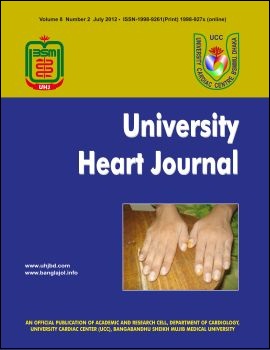Radiofrequency Catheter Ablation of Left-sided Accessory Atrioventricular Pathways at Atrial Insertion Sites.
DOI:
https://doi.org/10.3329/uhj.v8i2.16081Keywords:
Tachycardia, supraventricular, accessory pathway, retrograde aortic approach, atrial insertion site, catheter ablationAbstract
Background: This study assessed the efficacy and safety of techniques used to ablate left-sided accessory atrioventricular pathways at atrial insertion sites by retrograde aortic approach. Radiofrequency catheter ablation of left-sided accessory pathways by way of retrograde aortic approach can be highly successful.
Methods: This study were done in the department of Cardiology, National Institute of Cardiovascular Diseases (NICVD), Dhaka from June 2009 and March 2010, a total 30 patients with recurrent SVT who has left sided accessory atrioventricular pathways found after electrophysiological study, underwent attempted radiofrequency catheter ablation of one or more accessory atrioventricular pathways by retrograde aortic approach. The ablation catheter was inserted into the femoral artery and passed retrogradely across the aortic valve .Once an optimal target site has been identified, radiofrequency energy at a pre-selected temperature of 55 - 60 0 C and power output set at 50 watts was delivered through the ablation catheter. Loss of preexcitation or interruption of the tachycardia within 5 seconds of RF application was considered effective and RF current was continued in this location 30 to 60 seconds. Ablation success was defined at completion of procedure as acutely successful or unsuccessful on the basis of successful elimination of all ablation targets.
Results: During EP study it was found that 9 patients had concealed accessory pathways and 21 had manifest pre-excitation. WPW left-lateral pathway was present in 10 (33.3%), concealed left lateral in 08 (26.7%) ,WPW left posterior in 11 (36.7%), concealed left posterior in 1 (3.3%). Out of 30 accessory pathways, 24 were successfully interrupted with radiofrequency catheter ablation with a primary success rate of 80 %. The ratio of atrial/ ventricular electrogram in successful sites was 0.83 ±0.27 (0.53-1.46). There were no major complications with retrograde aortic approach. Six failed patients were ablated via transseptal method.
Conclusion: The retrograde atrial insertion approach to left-sided accessory pathway ablation is very safe and high effective, especially suitable for the failed patients by using retrograde ventricular insertion ablation procedure and by using single-catheter ablation of accessory pathway.
DOI: http://dx.doi.org/10.3329/uhj.v8i2.16081
University Heart Journal Vol. 8, No. 2, July 2012
Downloads
244
193




